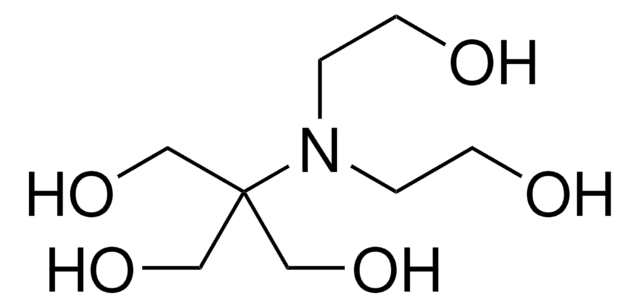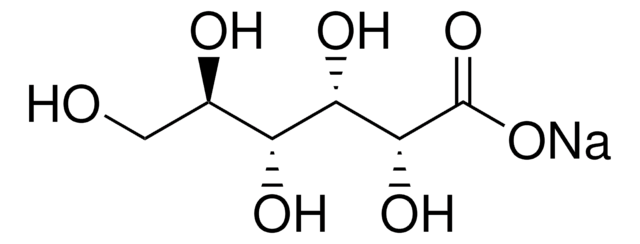T9784
Tricine
BioXtra, pH 4.0-6.0 (1 M in H2O), ≥99% (titration)
Synonyme(s) :
N-[Tris(hydroxyméthyl)méthyl]glycine
About This Item
Produits recommandés
Gamme de produits
BioXtra
Niveau de qualité
Essai
≥99% (titration)
Forme
powder
Impuretés
≤0.005% Phosphorus (P)
≤0.1% Insoluble matter
Résidus de calcination
≤0.1%
pH
4.0-6.0 (1 M in H2O)
Plage de pH utile
7.4-8.8
pKa (25 °C)
8.1
Solubilité
H2O: 1 M, clear, colorless
Traces d'anions
chloride (Cl-): ≤0.1%
sulfate (SO42-): ≤0.05%
Traces de cations
Al: ≤0.0005%
Ca: ≤0.0005%
Cu: ≤0.0005%
Fe: ≤0.0005%
K: ≤0.005%
Mg: ≤0.0005%
NH4+: ≤0.05%
Na: ≤0.005%
Pb: ≤0.001%
Zn: ≤0.0005%
Absorption
≤0.05 at 280 in H2O at 1 M
≤0.1 at 260 in H2O at 1 M
Application(s)
diagnostic assay manufacturing
Chaîne SMILES
OCC(CO)(CO)NCC(O)=O
InChI
1S/C6H13NO5/c8-2-6(3-9,4-10)7-1-5(11)12/h7-10H,1-4H2,(H,11,12)
Clé InChI
SEQKRHFRPICQDD-UHFFFAOYSA-N
Vous recherchez des produits similaires ? Visite Guide de comparaison des produits
Description générale
Application
- in a polymerase chain reaction (PCR) buffer used in the single-cell collection
- as a component of lactotroph feeding medium for culturing lactotrophs
- to prepare luciferase assay reagent for luciferase activity assay in firefly Photonis pyralis and as a component in Triton/glycylglycine lysis buffer
Vous ne trouvez pas le bon produit ?
Essayez notre Outil de sélection de produits.
Code de la classe de stockage
13 - Non Combustible Solids
Classe de danger pour l'eau (WGK)
WGK 3
Point d'éclair (°F)
Not applicable
Point d'éclair (°C)
Not applicable
Équipement de protection individuelle
Eyeshields, Gloves, type N95 (US)
Faites votre choix parmi les versions les plus récentes :
Déjà en possession de ce produit ?
Retrouvez la documentation relative aux produits que vous avez récemment achetés dans la Bibliothèque de documents.
Les clients ont également consulté
Notre équipe de scientifiques dispose d'une expérience dans tous les secteurs de la recherche, notamment en sciences de la vie, science des matériaux, synthèse chimique, chromatographie, analyse et dans de nombreux autres domaines..
Contacter notre Service technique





